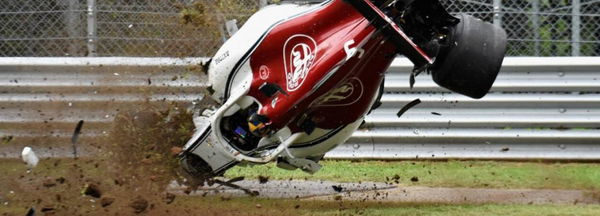
via Imago
Marcus Ericsson’s wild ride was prevented from have dire consequences because of the HAO

via Imago
Marcus Ericsson’s wild ride was prevented from have dire consequences because of the HAO
The incredible progress of safety in Formula 1 was thrust into the spotlight at the Belgian Grand Prix when Charles LeClerc escaped uninjured from his spectacular crash with Fernando Alonso.
Although there are no conclusions about how serious the accident would have been had the halo not been a mandatory part of F1, it is clear that the cockpit safety device did its job in ensuring that the Sauber driver walking away was not down to a matter of luck.
With the FIA having pursued the halo despite many critics suggesting it would ruin F1, FIA president Jean Todt and F1 race director Charlie Whiting have rightly earned praise for having the conviction not to back down in their pursuit.
LeClerc was not a particularly big fan of the halo when it was introduced. However, he changed his tune after what happened in Belgium. Now, he believes that it deserves to be in F1.

via Imago
The HALO does its job
“We cannot know what would have happened without it, but one thing is for sure – I would prefer to have had the doubt about whether it will or will not have touched my head, because if it was really touching my head then it could have been really bad.
Honestly I am very thankful that Jean introduced it in F1 and it has proved to everyone that it deserves to be here.”
According to Whiting, the investigation is not yet complete. However, initial investigations revealed that when Alonso’s wheel made contact with the halo it actually broke the suspension of the car.
Jean Todt admitted that he was a bit surprised about things the way they are happening. For decades, the FIA used motor racing as a show and also as a laboratory. They feel that each movement, each progress we can achieve in safety, is absolutely essential.
Motor racing, before Charles’ time was a disaster according to Todt. He said, “We have some tragic memories about that, and we know that motor racing will always be a dangerous sport – not only for the drivers but also for the officials, and for the spectators. If you are talking in rallying, on closed roads, the safety has increased but not at the level we can do on the circuit.
So we try to do the best, and we already felt that after some crashes which happened, some with consequences, some without consequences, we should already try to introduce a new step. And in fact it is something that was urged at the time by the drivers. I remember drivers writing to me and urging me: ‘Please do something’.

via Imago
Charles LeClerc
Sometimes, the frustrating thing is that when it was done, they were not so much convinced. But in a way we respect what they do and they should respect what we try to do. We did it because we were convinced it was a good thing.”
LeClerc also knew that it was important for the drivers to trust the FIA on safety matters. He is aware that there are a lot of people trying to develop the devices like the halo. Although he was not a particularly big fan of it, it has been implemented in F1 because it has been extensively tested.
They drew a comparison with Fernando Alonso’s crash in 2016 and Marcus Ericsson’s on Friday. The fact that they have survived such accidents, indicates how amazingly things have progressed.
Todt continued, “A few decades back, after [crashes like] that, drivers would not be there. It would be a big pain, because what was acceptable 40 years ago would not be acceptable now. And it could maybe mean that motor racing would be banned. Things have changed. So we must consider that.”
ADVERTISEMENT
ADVERTISEMENT
ADVERTISEMENT
ADVERTISEMENT
